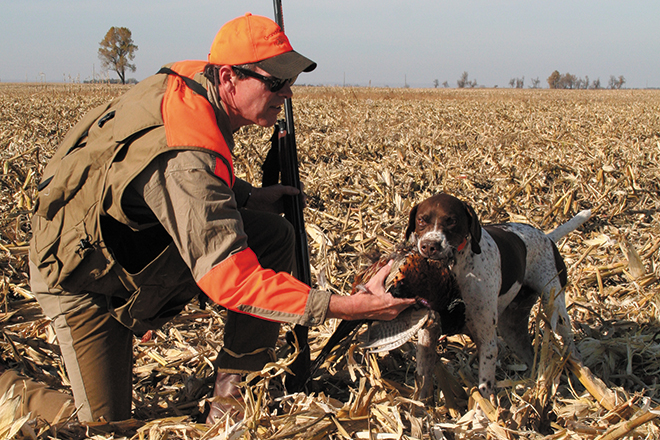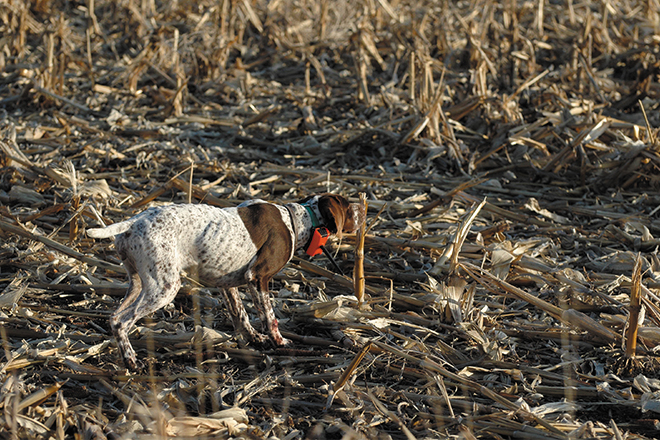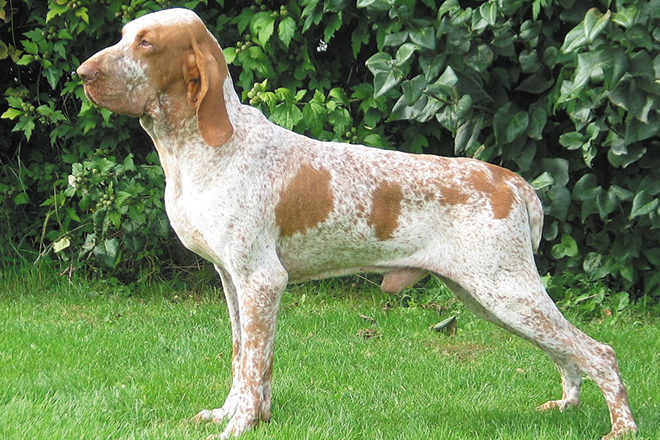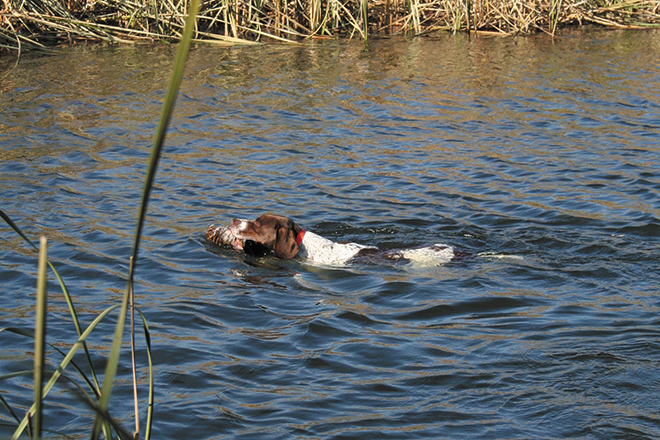Meet the Braque Francais: A versatile, hard-working and family-friendly bird dog
By Tom Carpenter
Braque (French, Verb) = To point, to lock.
It was classic South Dakota, and classic Braque work, both at their best.
Corn stubble butted up to a grass-lined wetland. As Brad Boisen and I approached from downwind, two brown-and-white dogs shook with excitement but stayed at heel even though their noses were aquiver.
Soon we were coursing the cover. Savvi and Cleo flowed with grace and efficiency – not too fast, not too slow – and crouched progressively lower to the ground as they homed in on pheasants.
When Savvi locked up, head almost on the ground and butt in their air, Cleo honored. I stepped in. Two roosters exploded out of the cattails. After whiffing on one bird, I settled down and swung on the easy shot. The longtail folded with a splash … right in the slough!
Not a problem. Savvi barreled in and finished his work, bringing the cockbird back to hand before shaking off and moving on.
 Above: A Braque brings a bird to hand.
Above: A Braque brings a bird to hand.
That evening, sitting on a couch watching football, the dogs snuggled and lounged at our sides, looking for some love.
Hard-working, versatile, family-friendly. That’s the Braque. These particular dogs happened to be of Braque Francais Pyrenean variety. But what about all the other kinds of Braques out there?
Let’s explore the upland pointing dog family known as the Braques, and define the breeds’ many qualities.
Braque History
Like all short-haired pointing breeds, Braques originated in Europe. The predecessor of today’s Braques was a big, burly, hound-like canine known as oysel.
Oysel developed on the Mediterranean flanks of the Pyrenees Mountains, in what is now France, Spain and Italy. This dog was bred for rough shooting; hunting’s goal was game on the campfire (feathered or furred), and not elegant dog work.
Jacques Espee de Selincourt, a huntsman for the French royalty, wrote of the Braque in his 1683 book “La Parfait Chasseur” (The Perfect Hunter): “He is a quite tall dog, very strong, with a robust chest, big head, long ears, good-sized nose, loose lips, and a white coat with brown spots.”
“This original Braque was the Braque Francais Gascogne,” says Boisen, who has been importing Braques from France to the U.S. since 1992. He has a Braques breeding program and hunts from his Grand Ciel Lodge.
 Above: Braques Francais Pyrenean on point.
Above: Braques Francais Pyrenean on point.
“My Braques are the Pyrenees variety,” says Boisen. Gascognes are now rare even in France. There are also Braque du Bourbonnais, Braque d'Ariège, Braque d'Auvergne, Braque du Puy, Braque Saint-Germain, and the related Bracco Italiano. In the United States, only the Pyrenean (2016), du Bourbonnais (2011) and Italiano (2001) are currently recognized by the American Kennel Club (AKC).
So why are there so many versions of the Braque? How do they differ, and not differ?
Braque Breeds
You can get as complex or as simple as you want with Braque history. Boisen makes it simple.
“They all descended from the Gascogne,” he says. “Then, as dogs got to different regions, they were bred for the game, terrain and habitat there.” Hounds contributed to the versioning, as did English pointers, and other small breeds. And it is probably no small coincidence that German shorthairs and Braques are similar in looks and hunting abilities.
 Above: Bracco Italiano
Above: Bracco Italiano
Boisen has a unique interest in the Pyrenees or Pyrenean version. “As society changed from almost purely rural and agrarian to being town and community oriented, property lines became tighter and a smaller. This version of the Braque emerged.” That’s parallel idea to how the Brittany developed in that region of France: Dogs for the common man and cottage dweller.
Here is a complete list of all the Braque breeds currently gracing our world:
Braque Francais Gascogne
Braque Francais Pyrenean
Braque du Bourbonnais
Braque d'Ariège.
Braque d'Auvergne.
Braque du Puy
Braque Saint-Germain
Bracco Italiano
Braque Qualities
Entire articles could be written about each of the Braque breeds. But they all share qualities as efficient hunters and loving pets.
“I am constantly amazed at how acute their sense of smell is. It is unmatched in the pointing dog world, in my opinion. I have consistently seen Braques locate birds from farther away, and find birds that other dogs missed,” says Boisen.
“Braques love to retrieve,” he adds. That was a requisite trait when lost game meant a lost meal. “Rare individuals that aren’t 100 percent naturals only take a little encouragement.”
 Above: Water retrieve.
Above: Water retrieve.
“By and large, they love water,” he adds. Dump a bird in the drink and a Braque is on it. “Combined with retrieving sense, they make great early season duck dogs. But the short coat keeps Braques on the sidelines for cold-weather water ducks.”
“All Braque breeds are easy to train,” adds Boisen. “They figure pointing out themselves. The trait is just in their genetic makeup. Get them in the field and on a few birds. That’s it. You can’t keep a Braque from hunting. And you can’t keep them from loving you up at home.”
Braques are versatile. They’re adept at bobwhites, big country (thinks Huns, chukars and desert quail), and cagey rosters. Many hunters take Braques into the grouse and woodcock woods.
Conclusion
A Braque is a Braque. The versions may look a little different, but they share virtues. It all comes down to one word, braque, which in French combines and describes the ideas of
point and
lock. Is there any simpler or better way to describe a bird dog?
Any Braque is worth exploring as your next hunting companion.
Tom Carpenter happens to own a French dog of the Brittany variety, but has a deep respect and admiration for that other accomplished French hunter, the Braque Francais.